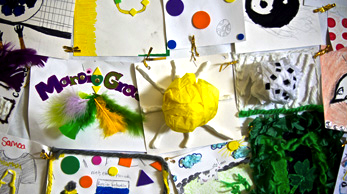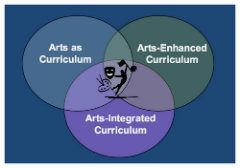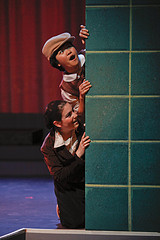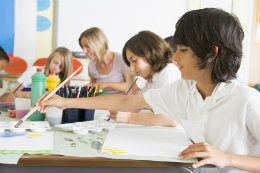Arts Integration: Catch the Thrill!
A MiddleWeb Resource Roundup
Beyond engagement and retention, adults and students at Bates [Middle School] cite numerous other benefits of arts integration: It encourages healthy risk taking, helps kids recognize new skills in themselves and others, provides a way to differentiate instruction, builds collaboration among both students and teachers, bridges differences, and draws in parents and the community. Plus it’s just plain fun.” ~ Mariko Nobori writing in an Edutopia Schools That Work series

The Kennedy Center for the Arts provides an in-depth look at arts integration at its ArtsEdge site, pointing out that the term goes beyond arts classes and enhancements in other courses to a full partnership. After careful deliberation, the Kennedy Center crafted this definition:
“Arts Integration is an APPROACH to TEACHING. Students Construct and Demonstrate UNDERSTANDING Through an ART FORM. Students Engage in a CREATIVE PROCESS Which CONNECTS an art form and Another Subject Area and meets EVOLVING OBJECTIVES in both.”
To see examples of arts integration in practice across language arts, science, social studies and math, explore the videos at the ArtsEdge page Arts Integration in Practice.
Jane Remer, a long-time educator and consultant with many clients including the Kennedy Center, advocates “all the arts for all the children, K-12.” In an article for ASCD, “Creating Rigorous Arts Lessons Across the Content Areas: Tips for Collaboration,” Remer reviews several large-scale projects and then goes on to outline how classroom educators can integrate arts into their classes, in part through consultation with arts educators. Her closing paragraphs offer guidelines for day-to-day success.
In
Arts integrators “have swum against a tide of stereotypes that keep the arts in the margin, despite their demonstrable and dramatic success in raising student achievement.”

As Vega points out, the efforts at Bates are based in part on the principles of Harvard’s Project Zero and its Artful Thinking project (here with an updated link). The Artful Thinking site is loaded with resources for the classroom, including wide ranging curriculum connections and links to images, museums and more.
Edutopia also provides links to fully developed lesson plans in several content areas for grades 6, 7 and 8, as well as professional development resources used in Anne Arundel County public schools and templates used at Bates. And if you’re a visual learner (smile) check out Edutopia’s Pinterest page on arts integration. Find more arts integration resources from Edutopia at Andrew Miller’s blog on integrating arts into project based learning.
With Connecting with the Arts, Annenberg Learner provides a series of video workshops for middle grades teachers. Watch to see teachers talk about arts integration and its value to students, strategies for collaborating with other educators, roles students adopt as part of AI, ways to connect across the curriculum, evaluation of learning, and more. The free workshop series is a companion to Annenberg’s collection of 12 Connecting with the Arts videos of visits to AI classrooms which can be purchased.
How relevant is arts integration, really?
In “The Social and Emotional Benefits of Being Weirdly Creative,” Edutopia editorial director David Markus quotes a Bates student: “At first you feel pretty weird, especially singing and dancing.… You think maybe someone will make fun of you. But because everybody has to sing and dance and do the art, everyone is in the same boat… (My source seems to relish this next part of his description.) So you have to keep doing the art day after day. You have to dance the motions of the planets or sing their name in a song or take a photo of a jungle gym exhibiting the properties of an isosceles triangle. And somehow, through all these awkward displays of creativity, the social playing field levels, and you actually start to have fun, and you begin to make friends with kids you might never have even spoken to, because they’re having fun, too.”
More insight about the potential impact of arts integration on schools, students and families can be found in the documentary video School Play, reviewed in this MiddleWeb article, “The Creative Lives of Children,” by K-6 principal Lyn Hilt. You can watch a trailer for the award-winning film at YouTube.

For educators who wonder how implementing the Common Core State Standards might relate to (and impact) arts integration, McREL’s Kirsten Miller provides some possibilities in “Common Core Quick-Start: How the Arts Intersect with the Common Core State Standards,” included in the recent ASCD Express issue, Thoughtful Arts Integration.
You’ll also find a detailed examination at The Arts and the Common Core: A Review of Connections Between the Common Core State Standards and the National Core Arts Standards Conceptual Framework. The document was prepared by the College Board for the National Coalition for Core Arts Standards in 2012. This coalition of arts education organizations plans to complete its re-imagining of national arts standards during 2013.
Update: Writing at Edutopia, Elena Aguilar suggests ways to integrate the arts into the post-test weeks to bring enthusiasm back into the classroom. (May 2013)
Image credits
Frontpage: STARSFoundation via Compfight (Creative Commons)
Art Display: Bates Middle School via Edutopia
Venn Diagram: ArtsEdge, Kennedy Center for the Arts
Children at wall: Santa Catalina School via Compfight (Creative Commons)


































